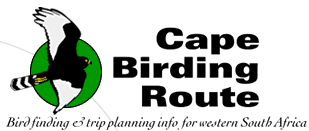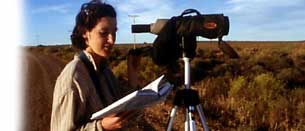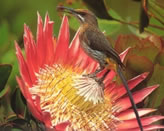Diamond
Coast: Port Nolloth to the Orange River
To
find the newly described Barlow’s
Lark, you will have to descend from the baking and
mountainous Namaqualand interior to the breezy scrublands
of the coastal plain. Take the N7 from Springbok north to
Steinkopf, checking for Lanner Falcon, Jackal Buzzard
and Black Crow perched on the telephone poles. Note
that the Jackal Buzzards in this area show a high incidence
of variable white mottling on the breast, often causing confusion
with the closely related Augur Buzzard, which only
occurs much further north, in Namibia. From Steinkopf, take
the R382 down Anenous Pass, which links the mountains to the
coastal plain and eventually brings you to Port Nolloth. Because
Barlow’s
and Karoo Larks are quite similar, it is worthwhile
familiarizing yourself with the locally occurring subspecies
of the latter. You will have this opportunity 5 km before
reaching Port Nolloth, where Karoo Lark (reddish-brown
upperparts; see box overleaf) occurs commonly in the roadside
scrub. Also keep a look out for Brants’s Whistling Rat
(Parotomys brantsii), which is quite common here as
well as in sandy areas throughout Namaqualand. More frequently
heard than seen, the rats draw attention to themselves by
a soft, high-pitched whistle before disappearing down their
extensive burrow systems.
Port
Nolloth is a damp, salty town, often swathed in dense, rolling
Atlantic fog. Most of the coastal strip of this region is
frustratingly off-limits to birders (it supports rich alluvial
diamond deposits). However, the most accessible site for Barlow’s
Lark is conveniently near the edge of town. Take the
road towards Alexander Bay, and about 1.6 km beyond the buildings
and the town’s last tarred side-road, you will see on
your left a fence demarcating the beginning of the mining
area at 1 (the fence is perpendicular to the road). Search
the low coastal dunes on the Port Nolloth side of the fence
for Barlow’s
Lark (cold brown upperparts; see box opposite), which
is common here. However, note that this site is just on the
edge of a zone of hybridization between Barlow’s
and Karoo Larks; be careful to distinguish pure birds
from the much scarcer hybrids (see box). Karoo Lark
(cold brown upperparts, see box) occurs again at McDougall’s
Bay, a few kilometres to the south of Port Nolloth (2). Other
birds found in the scrubby strandveld vegetation in this area
are Cape Long-billed Lark (see page on changing
bird taxonomy), Southern Grey Tit, Cape
Penduline Tit p.81), and Malachite and Lesser
Double-collared Sunbirds. Bradfield’s Swift
may be seen flying overhead anywhere in this area.
Port
Nolloth can also be a good place to see Damara
Tern, which breeds in low numbers from November to
February on the large pan on the northern edge of town 3.
Seabirds and waders along the Port Nolloth coast at 4 include
Bank (see p.21) and Crowned Cormorants, African
Black Oystercatcher (p.32*), White-fronted Plover
and, in summer, Grey Plover, Turnstone and Sanderling.
As
you head through the diamond area towards Alexander Bay, rainfall
decreases and the vegetation becomes lower and sparser. Check
the telephone poles for Black-breasted Snake Eagle,
Jackal Buzzard, Pale Chanting Goshawk and Lanner
Falcon. Tractrac Chat occurs on the roadside. The
private mining town of Alexander Bay has started to encourage
ecotourism in the area and provides access to the mouth of
the Orange, South Africa’s largest river. Its estuary
is an internationally-recognized RAMSAR wetland, offering
good birding. The Northern Cape Nature Conservation Service
is negotiating to include this rich area into a proposed transfrontier
reserve. The more notable species here include Greater
Flamingo, South African Shelduck, Cape Teal,
Maccoa Duck, African Fish Eagle, Avocet,
African Marsh Harrier, Caspian Tern, Damara
Tern (uncommon), Fan-tailed Cisticola, Cape
White-eye (see page on changing
bird taxonomy), Red-billed Quelea and Black-throated
Canary.
The
surrounds of Alexander Bay are strikingly desolate, the monochrome
landscape brightened only by the
bizarre orange of the giant-lichen-cloaked hill adjacent to
the turn-off to Alexander Bay. To find a pure population of
Barlow’s
Lark (that is, away from the hybrid zone), continue
past the turn-off to town, along the main road, which becomes
unsurfaced as it swings inland along the Orange River. Check
the area between Beauvallon and Brandkaros (10—20 km
beyond Alexander Bay), where Barlow’s
Lark (sandy-peach upperpart colorations, see box)
is present in the sparsely-bushed areas on the right hand
side of the road. Retrace your route to return to Springbok.
To
find the newly described Barlow’s
Lark, you will have to descend from the baking and
mountainous Namaqualand interior to the breezy scrublands
of the coastal plain. Take the N7 from Springbok north to
Steinkopf, checking for Lanner Falcon, Jackal Buzzard
and Black Crow perched on the telephone poles. Note
that the Jackal Buzzards in this area show a high incidence
of variable white mottling on the breast, often causing confusion
with the closely related Augur Buzzard, which only
occurs much further north, in Namibia. From Steinkopf, take
the R382 down Anenous Pass, which links the mountains to the
coastal plain and eventually brings you to Port Nolloth. Because
Barlow’s
and Karoo Larks are quite similar, it is worthwhile
familiarizing yourself with the locally occurring subspecies
of the latter. You will have this opportunity 5 km before
reaching Port Nolloth, where Karoo Lark (reddish-brown
upperparts; see box overleaf) occurs commonly in the roadside
scrub. Also keep a look out for Brants’s Whistling Rat
(Parotomys brantsii), which is quite common here as
well as in sandy areas throughout Namaqualand. More frequently
heard than seen, the rats draw attention to themselves by
a soft, high-pitched whistle before disappearing down their
extensive burrow systems.
Port
Nolloth is a damp, salty town, often swathed in dense, rolling
Atlantic fog. Most of the coastal strip of this region is
frustratingly off-limits to birders (it supports rich alluvial
diamond deposits). However, the most accessible site for Barlow’s
Lark is conveniently near the edge of town. Take the
road towards Alexander Bay, and about 1.6 km beyond the buildings
and the town’s last tarred side-road, you will see on
your left a fence demarcating the beginning of the mining
area at 1 (the fence is perpendicular to the road). Search
the low coastal dunes on the Port Nolloth side of the fence
for Barlow’s
Lark (cold brown upperparts; see box opposite), which
is common here. However, note that this site is just on the
edge of a zone of hybridization between Barlow’s
and Karoo Larks; be careful to distinguish pure birds
from the much scarcer hybrids (see box). Karoo Lark
(cold brown upperparts, see box) occurs again at McDougall’s
Bay, a few kilometres to the south of Port Nolloth (2). Other
birds found in the scrubby strandveld vegetation in this area
are Cape Long-billed Lark (see page on changing
bird taxonomy), Southern Grey Tit, Cape
Penduline Tit p.81), and Malachite and Lesser
Double-collared Sunbirds. Bradfield’s Swift
may be seen flying overhead anywhere in this area.
Port
Nolloth can also be a good place to see Damara
Tern, which breeds in low numbers from November to
February on the large pan on the northern edge of town 3.
Seabirds and waders along the Port Nolloth coast at 4 include
Bank (see p.21) and Crowned Cormorants, African
Black Oystercatcher (p.32*), White-fronted Plover
and, in summer, Grey Plover, Turnstone and Sanderling.
As
you head through the diamond area towards Alexander Bay, rainfall
decreases and the vegetation becomes lower and sparser. Check
the telephone poles for Black-breasted Snake Eagle,
Jackal Buzzard, Pale Chanting Goshawk and Lanner
Falcon. Tractrac Chat occurs on the roadside. The
private mining town of Alexander Bay has started to encourage
ecotourism in the area and provides access to the mouth of
the Orange, South Africa’s largest river. Its estuary
is an internationally-recognized RAMSAR wetland, offering
good birding. The Northern Cape Nature Conservation Service
is negotiating to include this rich area into a proposed transfrontier
reserve. The more notable species here include Greater
Flamingo, South African Shelduck, Cape Teal,
Maccoa Duck, African Fish Eagle, Avocet,
African Marsh Harrier, Caspian Tern, Damara
Tern (uncommon), Fan-tailed Cisticola, Cape
White-eye (see page on changing
bird taxonomy), Red-billed Quelea and Black-throated
Canary.
The
surrounds of Alexander Bay are strikingly desolate, the monochrome
landscape brightened only by the
bizarre orange of the giant-lichen-cloaked hill adjacent to
the turn-off to Alexander Bay. To find a pure population of
Barlow’s
Lark (that is, away from the hybrid zone), continue
past the turn-off to town, along the main road, which becomes
unsurfaced as it swings inland along the Orange River. Check
the area between Beauvallon and Brandkaros (10—20 km
beyond Alexander Bay), where Barlow’s
Lark (sandy-peach upperpart colorations, see box)
is present in the sparsely-bushed areas on the right hand
side of the road. Retrace your route to return to Springbok.
|


